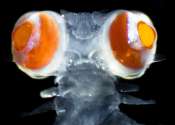The term worm is used to describe many different distantly-related animals which have a long cylindrical body and no legs.
Most animals called "worms" are invertebrates, but the term is also used for the amphibian caecilians and the slow worm Anguis, a legless burrowing lizard. Invertebrate animals commonly called "worms" include annelids (earthworms), nematodes (roundworms), flatworms, marine polychaete worms (bristle worms), marine nemertean worm ("bootlace worms"), and insect larvae such as caterpillars, grubs, and maggots.
Worms vary in size from microscopic to over a metre in length for marine polychaete worms (bristle worms), 6.7 m (22 ft) for the African giant earthworm, Microchaetus rappi, and 55 m (180 ft) for the marine nemertean worm (bootlace worm), Lineus longissimus.
Historical English-speaking cultures have used the (now depreciated) terms worm, wurm, or wyrm to describe carnivorous reptiles ("serpents"), and the related mythical beasts dragons.
Various types of worm occupy a wide variety of parasitic niches, living inside the bodies of other animals. Free-living worm species may live on land, in marine or freshwater environments, or burrow.









